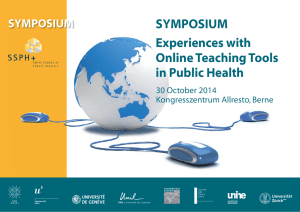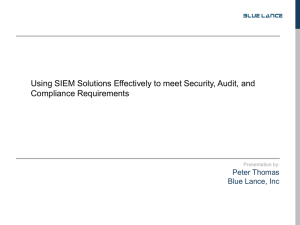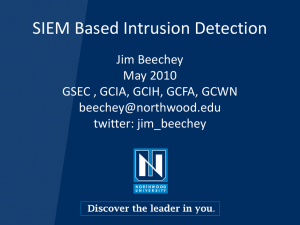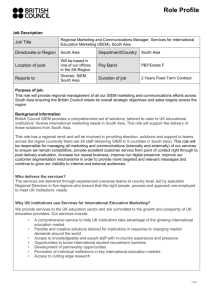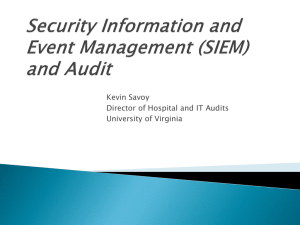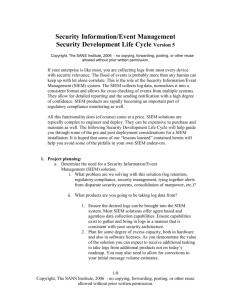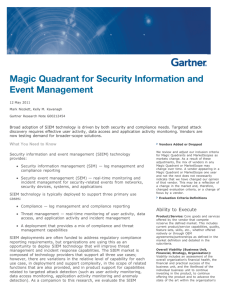Cultural Informant - SIEM | Spaces of International Economy and
advertisement
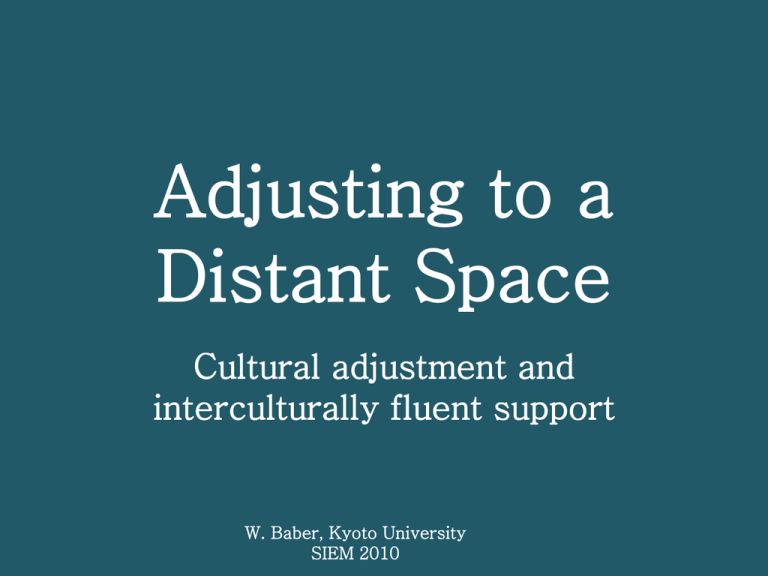
Adjusting to a Distant Space Cultural adjustment and interculturally fluent support W. Baber, Kyoto University SIEM 2010 Question 1 • What do individuals around foreign managers add to the adjustment process they experience working in Japan? • Not clear, but becoming clearer – Information, interpretation of culture, guidance on the hybrid track March 2010 SIEM Symposium 2 Question 2 • Who are these individuals who impact the adjustment of foreign managers? o Cultural informants o Interculturally fluent informants o Mentors March 2010 SIEM Symposium 3 Definitions • What Cultural Adjustment means (Berry, 1997) – Integrated-Assimilated-Separated-Marginalized Integrated: able to access home/host cultures • Culture – the widely understood and accepted ways of doing things (Hunt, 2007) • Mentors • Cultural informants • Interculturally fluent informants March 2010 SIEM Symposium 4 Cultural Informants • Who – potentially any individual around the manager • Boss, Co-worker, Spouse, Expat, Local, In-laws, Children • Generally drawn from the networks around the foreign manager March 2010 SIEM Symposium 5 Cultural Informants Flow of Information Foreign Manager Individuals March 2010 SIEM Symposium 6 Cultural Informants - Descriptors • • • • • • • • • • Partially or very proficient in target language and culture; Not necessarily related to work world; Need not be established in work or society; Need not be technically proficient; Advises in situational incidents in business and other areas; Expatriates may have more than one cultural informant; Need not be a deep personal relationship; Provide ad hoc advice; Accessible, even giving instant feedback; Socially embedded in the target culture, or even in both cultures; • Advise on social cues; 7 Cultural Informants – Examples – A: significant other, co-worker – C: acquaintance with relevant business and life experience – D: superior with extensive business and cultural experience in both home and target cultures – E: spouse and business partner – F: familiar with Japan and the home country, but low accessibility – G: acquaintance with extensive business and cultural experience in both home and target cultures 8 Cultural Informants • Not defined by quality! • Not defined by ability to transmit or interpret knowledge! March 2010 SIEM Symposium 9 Cultural Informants – Examples – other, co-worker – A: D: significant superior with extensive business and cultural in both home and target cultures – experience C: acquaintance with relevant business and life experience – G: extensive business and D: acquaintance superior with with extensive business and cultural cultural experience in both home andcultures target experience in both home and target – cultures E: spouse and business partner – F: familiar with Japan and the home country, but low accessibility – G: acquaintance with extensive business and cultural experience in both home and target cultures 10 Interculturally Fluent Informants • Highly fluent in home and host languages, work and life culture; • Aware of subtle variations among groups and regions in home and host cultures; • Embedded in social networks of home and host cultures, for example: – Professional associations; Alumni networks; Social organizations; • Readily available and in frequent contact; March 2010 SIEM Symposium 11 Interculturally Fluent Informants Very likely to accurately transmit deep understanding of host culture to the foreign manager March 2010 SIEM Symposium 12 Hybrid Manager • Notion from Schlunze and Plattner • A manager with one foot in each of two (or more) worlds – Not a manager with abstract knowledge – Real cultural, professional, personal knowledge – Local network, local language, cultural skills • Hybrid managers develop over time if the conditions are right March 2010 SIEM Symposium 13 Elements of Cultural Adjustment • 12 elements identified in interviews for managers who are or are becoming hybrids • Other aspects of cultural adjustment: – cultural distance, language proficiency, expatriate type, and personality traits such as emotional stability and cultural empathy (Peltokorpi, 2008) – psychic distance March 2010 SIEM Symposium 14 Next Questions • • • • Is there a Hybrid Track? Where is a person in the process? How can we compare managers? How can we know what should be developed in order to generate well rounded hybrids? March 2010 SIEM Symposium 15 Hybrid Track • Language skills • Networks – foreigner/Japanese, professional/personal • Involvement • • • • • – Decision making – Day-to-day work participation Ambition/Strategic Intent Informants (Business/Life) Personal relationship(s) Cultural skills Capacity for synergy: globalizer, localizer, local/global networker (Schlunze) March 2010 SIEM Symposium 16 Language Skills Personal Relationships 5 4.5 Cultural Skills 4 3.5 Network, Professional, Jp 3 2.5 Day to Day Work 2 A 1.5 Network, Professional, Foreign 1 C 0.5 0 Ambition D E Network, Personal, Jp Decision Making F G Network, Personal, Foreign Informant, Cultural Informant, Business March 2010 SIEM Symposium 17 Mentor Functions and Attributes • Guide into management; • Established person in their field, but not necessarily socially • • • • • • • • • embedded; Technically proficient in their field; Offers work related network access; Offers some behavioral guidance; Advises in situational incidents related to business and management; May support specific career goals with mentee; Because of high status, may offer only low or moderate accessibility, but is committed; Mentee usually has only one mentor; Trusting relationship; On-site or home country; March 2010 SIEM Symposium 18 Bibliography •Attinasi, J. & Friedrich, P. (1995). Dialogic breakthrough: Catalysis and synthesis in life-changing dialogue. In The Dialogic Emergence of Culture. (Eds. B. Mannheim and D. Tedlock). pp. 33-53. University of Illinois Press: Champaign, IL •Bandura, A. (1977). Social learning theory. Englewood Cliffs, NJ: Prentice-Hall •Baskerville-Morely, R.F. (2005). A research note: the unfinished business of culture. Accounting, organizations and society. 30, pp. 389-391. •Brisco, D.R. & Schuler, R.S. (1995). International human resource management, 2nd edition. New York: Routledge •Coan, J. and Allen, J. (2007). Handbook of emotion elicitation and assessment. New York: Oxford University Press US •Crosby, F. (1999). The developing literature on developmental relationships. In Mentoring dilemmas. (Eds. A. Murrell, F. Crosby & R. Ely). Mahwah, NJ: Erlbaum •Feldman, D.C. & Bolino, M.C. (1999). The impact of on-site mentoring on expatriate socialization: a structural equation modeling approach. International journal of human resource management. 10 (1), p. 54-71 •Furnham, A. & Bochner, S. (1986). Culture shock. New York: Methuen •Goodenough, W. (1973). Culture, language, and society. Reading, MA: Addison-Wesley •Granovetter, M. (1985). Economic action and social structure: The problem of embeddedness. American journal of sociology. Vol 91, (3), p. 481-510 •Gullahorn, J.T. and J.E. Gullahorn. 1963 An Extension of the U-Curve Hypothesis. Journal of Social Issues. Vol. 19. (3), p. 33-47 •Gudykunst, W. & Nishida, T. (1994). Bridging Japanese/North American differences. Thousand Oaks: Sage Publications •Hofstede, G. (1986). Cultural differences in teaching and learning. International Journal of Intercultural Relations. Vol. 10, 301-320 •Hofstede, G. (2001). Culture’s consequences. Thousand Oaks: Sage Publications •Hofstede, G. & Hofstede, J.H. (2005). Cultures and organizations: Software of the mind. New York: McGraw-Hill •Hunt, R.C. (2007). Beyond relativism: Rethinking comparability in cultural anthropology. Lanham, MD: AltaMira Press •ITIM International, (2009). Retrieved February 25, 2009 from: www.geert-hofstede.com •Kay, D. & Hinds, R. (2007). A practical guide to mentoring: play an active and worthwhile part in the development of others, and improve your own skills in the process, 3rd edition. How to books: Oxford •Kram, K. (1988). Mentoring at work: Developmental relationships in organizational life. University Press of America: Lanham, MD •Kramsch, C. (1991). Foreign language research in cross-cultural perspective. ( Eds. K. De Bot, C. Kramsch, & R. Ginsberg). Amsterdam: John Benjamins BV •Kramsch, C. (1996). Context and culture in language teaching. 3rd edition. Oxford: Oxford University Press March 2010 SIEM 19 Symposium Bibliography •Leonard, D. and Swap, W. (2005). Deep smarts. Boston: Harvard Business School Press •Mead, R. (2005). International Management – Cross-cultural dimensions, 3rd edition. Malden, MA: Blackwell Publishing •Oberg, K. (1960). Culture shock: Adjustment to new cultural environments. Practical anthropology, 7, p. 177-182 •Peltokorpi, V. (2008). Cross-cultural adjustment of expatriates in Japan. The international journal of human resource management. Vol. 19, No. 9, p. 1588–1606 •Petersen, B. (2004). Cultural intelligence: A guide to working with people from other cultures. Boston: Intercultural Press •Plattner, M. (2008). Mobile eliten im 21. jahrhundert. JapanMarkt, 17, (12), p. 30-32 •Polanyi, M. (1967). The tacit dimension. London: Routledge and Kegan Paul Ltd •Schlunze, R.D. and Plattner, M. (2007). Evaluating international managers' practices and locational preferences in the global city - An analytical framework. Ritsumeikan business review (ritsumeikan keiei gaku). 46, (3), p. 63-90 •Schlunze, R.D., (2007). Spurring the Kansai economy – Embedding foreign corporations. Ritsumeikan international affairs (ritsumeikan kokusai chiiki kenkyu), 5 (6), p. 17-42 •Szkudlarek, B. (2005). Book Review: Building cross-cultural competence: How to create wealth from conflicting values. Management Learning. 36; 518-523 •THT Consulting, (2009). http://www.7d-culture.com/Content/cont042.htm Retrieved February 24, 2009 from http://www.7dculture.com •Thomas, D.C. (1998). The expatriate experience. In J.L.C. Cheng and R.B. Petersen (Eds.), Advances in international comparative management, Vol. 12, JAI Press: Stamford and London •Thomas, D.C. (2008). Cross-cultural management, 2nd edition. Thousand Oaks: Sage Publications •Trompenaars, F. and Hampden-Turner, C. (1998). Riding the waves of culture: Understanding diversity in global business. New York: McGraw Hill •University of Minnesota. Learning Abroad Center. Retrieved February 12, 2009 from http://www.umabroad.umn.edu/parents/preDepartureCrossCultural.html •Ward, C., Bochner, S., & Furnham, A. (2001) The psychology of culture shock. Hove: Routledge •Zachary, L. (2000). The Mentor’s Guide. Hoboken, NJ: John Wiley & Sons March 2010 SIEM Symposium 20
